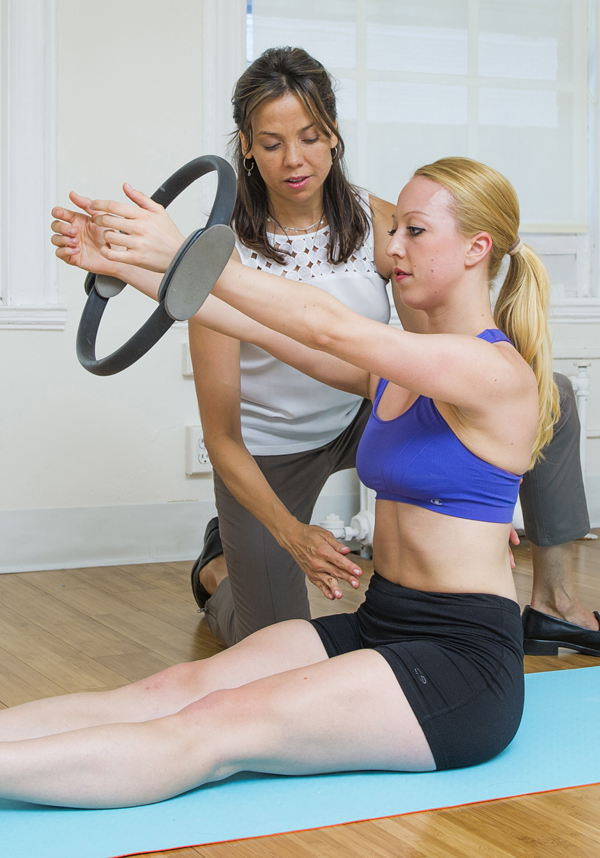
31 Aug Sitting 5 Minutes a Day Can Balance the Core
SIT FOR CORE ACTIVATION
Five minutes of sitting per day can improve the balance in your core. It’s easier than you think, and maybe you already have a feel for the idea. The core is a three- dimensional system comprised of many muscles including the diaphragm, pelvic floor, transversus abdominis and multifidi.
When sitting properly, it is possible to relax tight muscles, engage weak muscles and change the length-tension relationships of the muscles that make up our support system. Balancing the firing patterns of these muscles can keep your back and neck in a healthier state.
PELVIC FLOOR SITTING
There are many steps to the process. Begin by finding a firm, flat seat that is positioned higher than your knees. This will make it easier to sit on the pelvic floor. The pelvic floor is the triangle between your “sits” bones and your pubic bone.
Most people sit improperly on the back of the bottom or the sacrum and will need to roll the belly forward. Some people will need to roll the belly backward to load the pelvic floor. Be mindful to drive the movement from your hips and not from your chest or upper trunk. When sitting on your pelvic floor, the rest of your spine is likely to align itself with proper shock absorbing curves throughout.
SHORT INTERVALS
Start with small intervals of one minute five times per day. In a matter of six weeks time, you will notice you are sitting properly without even thinking about it.
AGONIST/ANTAGONIST ANATOMY
Balance is what makes the body happy. Often the reason you adopted the poor posture originally was to avoid pain and release tension. Over time compensatory ways of standing and sitting wreak havoc on our bodies.
In my practice as a physical therapist, I have treated many well-intentioned and disciplined patients who worked vigorously to keep their bodies fit and healthy. Often they have overdeveloped one muscle group at the expense of the opposing muscle group. For example, clients often train their abdominals to excess and under train opposing back muscles, causing an imbalance that can lead to joint pain or poor form.
Five to ten years of sitting during a 40 hour work week amounts to 10,000-20,000 hours of sitting. Profound changes can happen in our bodies depending upon the posture we maintain during this time. Choosing a good sitting posture is one key stone step in creating proper length tension relationships throughout our core.
The body is beautiful and amazing. Be mindful and smart with it. The answer is not always working harder; it’s doing the right things to care for it. Your body and the quality of the life you lead is worth five minutes in order to improve the experience within, in order to focus on other aspects of your life. Sit on your pelvic floor, and balance your core.
BODY MINDFULNESS
Occasionally when attempting to sit or stand properly, you may feel some discomfort. This is a sure sign that those particular joints or tissues in your body may have tightness or restriction, or you may have some other underlying condition. If assuming a better posture position causes pain, listen to your body, assume a position of comfort, and seek the opinion of a licensed physical therapist or medical professional. The contents of this blog are for informational purposes only and are not a substitute for professional medical advice, diagnosis, or treatment.
Reference
De Bruyne MA., Et al. Influence of different stool types on muscle activity and lumbar posture among dentists during a simulated dental screening task. Apple Ergon. 2016 Sep:56:220-6, doi: 10,1016/j.apergo.2016.02.014. Epub2016 Mar11.
Johnson, Vicki. Course presentation: Institute of Physical Art: BET (Back Education and Training) at Long Island University; 02/ 2008 & 01/2005.: Brooklyn, NY.
Netter, Frank H. Atlas of Human Anatomy: East Hanover, NJ: Novartis, 1997. Print.
Shin Sh Et al., A study on trunk muscle activation patterns according to tilt angle during whole body tilts. Technol Health Care. 2017 Jul 20; 25(S1): 73-81. doi: 10.3233/THC-171308.
